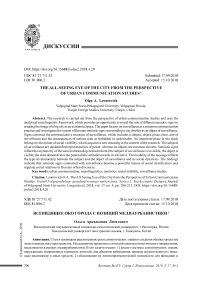The all-seeing eye ofthe city from the perspective of urban communication studies
Автор: Leontovich Olga A.
Журнал: Вестник Волгоградского государственного университета. Серия 2: Языкознание @jvolsu-linguistics
Рубрика: Дискуссии
Статья в выпуске: 4 т.17, 2018 года.
Бесплатный доступ
The research is carried out from the perspective of urban communication studies and uses the analytical sociolinguistic framework, which provides an opportunity to reveal the role of different semiotic signs in creating the image of a big city as an existential space. The paper focuses on surveillance as a common communication practice and investigates the system of Russian semiotic signs surrounding a citydweller as an object of surveillance. Signs construct the communicative situation of surveillance, which includes a subject, object, place, time, aim of surveillance and the consequences of actions seen as forbidden or undesirable. An important place in the study belongs to the notion of social visibility, which acquires a new meaning in the context of the research. The subjects of surveillance are unidentified representatives of power, whereas its objects are common citizens. Semiotic signs reflect the asymmetry of the social relationship between them (the subject of surveillance is invisible, the object is visible; the state demonstrates the paternalistic attitude towards its citizens). The modality of the message reflects the type of relationship between the subject and the object of surveillance and its social dynamics. The findings indicate that semiotic signs connected with surveillance become a powerful means of social stratification and regulate social relations in Russian urban discourse.
Urban communication, sociolinguistics, semiotics, social visibility, surveillance studies
Короткий адрес: https://sciup.org/149129931
IDR: 149129931 | DOI: 10.15688/jvolsu2.2018.4.20
Список литературы The all-seeing eye ofthe city from the perspective of urban communication studies
- Aiello G., Tosoni S., 2016. Going About the City: (Methods and Methodologies for Urban Communication Research. International Journal of Communication, no. 10, pp. 1252-1262.
- Anderson F., Boyd-Franklin N., 2000. Invisibility Syndrome: A Clinical Model of the Effects of Racism on African-American Males. URL: https://www.bc.edu/content/dam/files/centers/boisi/pdf/f08/Invisibility_Clinical_Model-Ortho-.pdf.
- Blommaert J., 2005. Discourse. A Critical Introduction. Cambridge, Cambridge University Press. 314 р.
- Brooks K., Gelderen T., 2008. Fighting invisibility: The recognition of migrant domestic workers in the Netherlands. URL: https://www.humanityinaction.org/knowledgebase/103-fighting-invisibility-the-recognition-of-migrant-domestic-workers-in-the-netherlands.
- Bryman A., 2008. Social Research Methods. Oxford, New York, Oxford University Press. 747 p.
- Fairclough N., 2003. Analysing Discourse. New York, Routledge. 270 p.
- Fijnaut C., Marx, G.T., 1995. Undercover: Police surveillance in comparative perspective. Norwell, Kluwer Academic Publishers. 343 p.
- Foucault M., 1977. Discipline and Punish. Harmondsworth, Penguin. 333 p.
- Genosko G., Thompson S., 2006. Administrative surveillance of alcohol consumption in Ontario, Canada: pre-electronic technologies of control. Surveillance & Society, vol. 4, no. 1/2, pp. 1-28.
- Genosko G., Thompson S., 2009. Punched drunk: alcohol surveillance and the LCBO 1927-1975. Nova Scotia, Fernwood Publishing. 222 p.
- Goold B., 2004. CCTV and policing: Public area surveillance and police practices in Britain. Oxford, Oxford University Press. 260 p.
- Green N., Zurawski N., 2015. Surveillance and Ethnography: Researching Surveillance as Everyday Life. Surveillance and Society, vol. 13, no. 1, pp. 27-43.
- Jones H., 2005. Visible rights: Watching out for women. Surveillance & Society, vol. 2, no. 4, pp. 589-593.
- Lyon D., 2002. Editorial. Surveillance studies: understanding visibility, mobility and the phenetic fix. Surveillance & Society, vol. 1, no. 1, pp. 1-7.
- Lyon D., Bennett C., 2008. Playing the ID card: Understanding the significance of identity card systems. Lyon D., Bennett C., eds. Playing the identity card: surveillance, security and identification in global perspective. London, Routledge, pp. 3-20.
- Mehrabov I., 2015. Exploring Terra Incognita: Mapping surveillance studies from the perspective ofmedia and communication research. Surveillance and Society, vol. 13, no. 1, pp. 117-126.
- Mirzoeff N., 1999. An Introduction to visual culture. London, Routledge. 288 р.
- Ridell S., Zeller F., 2013. Mediated urbanism: Navigating an interdisciplinary terrain. International Communication Gazette, vol. 75, no. (5-6), pp. 437-451.
- Rule J.B., Greenleaf G.W., 2008. Global privacy protection: the first generation. Cheltenham, Edward Elgar. 318 р.
- Scotland-Stewart L., 2007. Social invisibility as social breakdown: Insights from a phenomenology of Self, World, and Other. Stanford, Stanford University. 235 р.
- Gibson T.A., Lowes M. (eds.), 2007. Urban communication: Production, text, context. Lanham, MD, Rowman & Littlefield. 241 р.
- Walby K., 2002. Little England? The Rise of Open- Street Closed Circuit Television. Surveillance & Society, vol. 4, no. 1, pp. 29-51.


